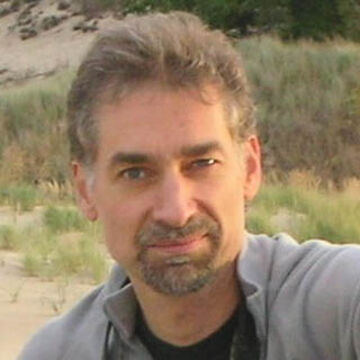

Eric Leonardson
Professor, Adjunct
Contact
Bio
BFA, 1980, Northern Illinois University; MFA, 1983, School of the Art Institute of Chicago. Concurrent Positions: World Forum for Acoustic Ecology, Midwest Society for Acoustic Ecology, World Listening Project. Exhibitions/Performances/Broadcasts: Art Institute of Chicago; Steppenwolf Theater, Chicago; Museum of Contemporary Art, Chicago; New Music Circle, St. Louis; High Zero, Baltimore; Outer Ear Festival of Sound, Chicago; Beyond Music Festival, Venice, CA; Deep Wireless, Toronto; Radio Revolten, Halle, Kunstradio, Vienna; B-3 Biennale, Frankfurt. Recordings: Radio Reverie In the Waiting Place, Rarebit, Rub. Publications: Experimental Musical Instruments; Leonardo Music Journal; Musicworks; P-Form. Awards: Illinois Arts Council.
Personal Statement
I model my teaching after my own teachers, who challenged me with provocative questions. Seeking my own answers, I constructed new knowledge and defined my identity. My students join a lineage of reflective, rigorous and constructive learning. My students discover their own their own creative voices, and define new ways of thinking and making.
Much of my teaching includes advising. If advising is an act of giving, I would like to give more than just words. I like listening. It is a cognitive process and embodied practice I explore, and even perform. Verbalizing about process, goals, technique, or any other aspect of the creative endeavor is the core of our effort: a reciprocal relationship in which the faculty advisor's role is as a sounding board for ideas about the sophisticated making in which both graduate and undergraduate students are engaged. Uncertainty, vulnerability: these may be the difficult conditions to live with. However, they may be necessary for positive growth. It is truly a pleasure to find and use words that effectively express the more ineffable and elusive aspects of making art and art made.
Graduate advising is the essential means by which SAIC delivers its service through dedicated one-on-one dialog between a student and their advisor as teacher, mentor, and colleague. Advising is doing as well as dialog. Making is thinking and vice versa. I like walking, for example. It is good for my thinking, and so is being outdoors. As my practice involves active engagement in soundscape awareness and music performance, soundwalking offers an embodied practice. It is a very practical way to find answers, to reflect, to plan, and accomplish many other tasks. The results in turn may be of a highly theoretical nature or of a mundane order. Multiple modes of knowing and learning are supported in SAIC's interdisciplinary approach and culture. This includes the advising experience. Studio visits, attending performances, and exhibitions are part of how I expect to actively engage and collaborate with my students' art in order to grasp their ways of knowing and learning.
I thrive on learning. As a SAIC graduate (MFA 1983) teaching here since 1997, my interdisciplinary, multimedia practice employs sound, performance, instrument construction, field recording, electronic music composition, improvisation, sound design for film, radio, and theater, video, transmission art, touring, soundwalking, writing, painting, drawing, photography, and sculpture. Because of my efforts in the field of acoustic ecology, science and technology in relationship with art and society deeply informs my practice.
History is very important in my life and work, as is community, so is a sense of belonging as well as a sense of place. I support the development of students’ artistic abilities in relationship with the historical, social, and theoretical underpinnings of their work and life as well as their professional viability.